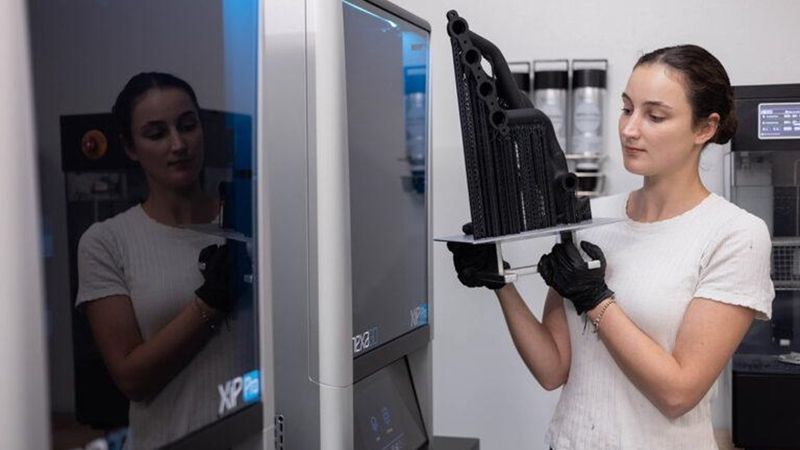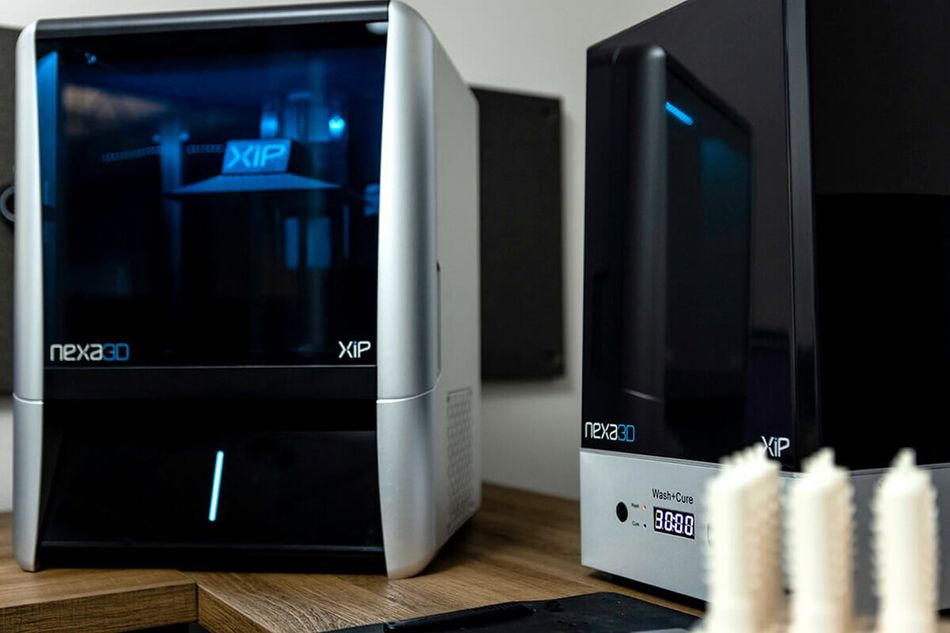Ultrafast resin 3D printing accelerates design iteration and development
Nexa3D’s patented Lubricant Sublayer Photo-curing (LSPc) technology can print at up to 24 vertical centimeters per hour. That means more prototypes in less time.
3D printing is a valuable tool for prototyping, design iteration, and product development. Faster than subtractive processes like CNC machining and significantly faster than tool-based processes, 3D printing is also relatively inexpensive. This makes it possible to prototype one design after another with minimal fuss.
One of the major 3D printing technologies for prototyping is vat photopolymerization or resin 3D printing. This technology can produce more detailed and professional-looking prints than extrusion printing, making it the technology of choice in fields like dentistry and jewelry. However, most resin 3D printers lack the speed to produce multiple unique prototypes within a working day.
But what if this important hurdle could be overcome? This article looks at how an exciting new technological development in resin 3D printing has massively accelerated the iterative prototyping process.
Design iteration possibilities with resin 3D printing
These days, many R&D departments have their own resin 3D printer. That’s because resin printing checks many boxes as a prototyping technology: it achieves fine details, produces a much better surface finish than fused filament fabrication (FFF), and offers a range of materials to cover most scenarios. And, as with all 3D printing technologies, it can make prototypes faster than traditional technologies like molding since there is no tooling stage.
One of the biggest advantages of resin 3D printing is its ultra-smooth surface finish. Where FFF produces a rough texture and the dreaded stair effect on curved areas, resin 3D printing achieves a finish closer to injection molding. With stereolithography (SLA), one of the major resin printing technologies, the typical surface roughness is between 0.4 and 2 μm.[1] In the product development stage, this provides an important advantage over FFF prototypes, as resin prototypes more closely resemble mass produced final parts.
Bottlenecks with standard resin printers
We’ve seen why companies enjoy using resin 3D printers for product development, but there are limitations to the technology too. The nature of those limitations depends on the type of resin 3D printer being used.
Stereolithography is perhaps the most well-known form of resin printing. After all, it is the original 3D printing technology, invented and patented back in the 1980s. This technology uses a laser beam as a light source to cure the liquid resin. While this is great for accuracy, it makes for a painstakingly slow 3D printing process. In a day of printing, you might get one very neat prototype, but you’d struggle to thrash out a quick sequence of designs. The solution might be to use multiple SLA printers side by side, but this introduces massive additional investment costs, as well as operational and maintenance requirements. This can be justified for production but rarely during the prototyping stage.
Fortunately, there are faster forms of resin 3D printing, such as digital light processing (DLP) and masked stereolithography (mSLA). Both of these technologies can cure a full layer of a print at once. They do this by projecting or tracing a complete 2D image onto the photocurable resin, rather than “drawing” it line by line. (If SLA resembles drawing a picture with a pencil, mSLA is like using a printing press and DLP is like spray painting through a stencil.)
However, even these faster technologies have their limitations. Most resin printers have very small build volumes, making it difficult to crowd several parts into one build. This significant bottleneck can tempt product designers into using alternative technologies like large-format extrusion 3D printers.
How LSPc technology enables ultrafast design iteration
An ideal tool for design iteration would be a resin 3D printer that exploits the technology’s main advantages while opening up its most significant bottlenecks. But how would that be achieved? Certainly, DLP and mSLA are faster than SLA, but some popular systems lack the quality of SLA. We’ve also noted that simply running multiple machines simultaneously adds significant cost.
One company offering a genuine solution to this problem is Nexa3D. With its XiP and XiP Pro machines, Nexa3D presents a new form of bottom-up resin 3D printing that uses smart innovations to turn one of the faster forms of resin printing into something even faster. It calls this technology Lubricant Sublayer Photo-curing (LSPc).
Ultrafast printing coupled with a large build volume leads to rapid design iteration (image: Nexa3D)
Ultrafast printing
At its core, LSPc is a form of masked SLA, a technology that uses an LCD screen on top of a powerful LED array to selectively cure resin. Masked SLA is generally more efficient and reliable than other resin technologies.[2] However, LSPc introduces a few key innovations that dramatically accelerate printing: the XiP Pro can print its full build volume in under two hours, at a rate of 24 cm per hour.
One unique feature that contributes to this speed is the highly lubricious Everlast membrane that gives the technology its name. Bottom-up resin printing requires a transparent window between the light source and the resin tank. But this window can be a sticky subject: the part must detach from it at each layer interval, putting all of the required separation force onto the part and risking layer delamination.[3] Several 3D printer manufacturers have proposed a solution to this issue, but Nexa3D’s special Everlast membranes are one of the most promising methods. As flexible as silicone but with superior shape retention and chemical resistance, these membranes allow the part to detach smoothly and quickly without causing delamination. Resin replenishment cycles are therefore shortened, increasing the printing speed.
Another unique innovation is the open architecture and efficient cooling fan of Nexa3D’s LSPc machines. This combination prevents excessive heat buildup, allowing the printer’s 200-diode LED array to provide maximum light generation (and shorter curing times) without the risk of damaging the part through a runaway thermal reaction.
The results of these technological innovations are significant. A part that takes 165 minutes on a professional-grade SLA printer can be printed in just 24 minutes using LSPc.
Large capacity
LSPc provides a speed increase in terms of the millimeters built along the Z axis per hour. But the XiP and particularly the XiP Pro also provide increased throughput via their larger build volumes. The XiP Pro has a significantly larger build area than most resin printers on the market.
| X (mm) | Y (mm) | Z (mm) |
Typical resin printer | 140 | 140 | 180 |
XiP | 195 | 115 | 210 |
XiP Pro | 292 | 163 | 410 |
Not only does this allow for larger prototypes and the potential for production-level throughput, it also allows users to fill the build area with duplicates of a single design — helpful for sending the design to multiple departments for testing and analysis — or with multiple unique designs, enabling rapid iterative prototyping. Nexa3D’s NexaX software facilitates this process with an automatic XY nesting feature.
This large build area has no adverse effect on print quality. In fact, a slightly larger vat helps reduce heat buildup, preventing deformities and allowing for faster resin replenishment.
New possibilities
Exciting new technologies like LSPc are moving the goalposts in terms of product development. Companies can now print half a dozen unique designs in a single day, rather than waiting days or weeks for each successive iteration. This means more time for design, better and more comprehensive testing, and shorter time to market.
References
[1] Lu SS. Improving surface quality of SLA 3D printed parts via controlled dip-coating (Doctoral dissertation, Massachusetts Institute of Technology).
[2] Gaikwad SR, Pawar NH, Sapkal SU. Comparative evaluation of 3D printed components for deviations in dimensional and geometrical features. Materials Today: Proceedings. 2022 Jan 1;59:297-304.
[3] Song H, Rodriguez NA, Seepersad CC, Crawford RH, Chen M, Duoss EB. Development of a variable tensioning system to reduce separation force in large scale stereolithography. Additive Manufacturing. 2021 Feb 1;38:101816.


